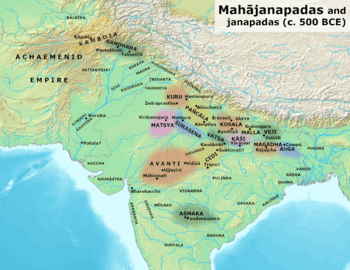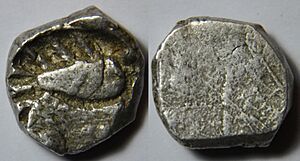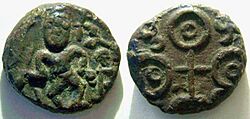Avanti (region) facts for kids
Quick facts for kids
Kingdom of Avanti
|
|||||||
|---|---|---|---|---|---|---|---|
| c. 700 BCE–c. 300 BCE | |||||||

Avanti and other Mahajanapadas in the Post Vedic period.
|
|||||||
| Capital | Ujjayini | ||||||
| Common languages | Sanskrit | ||||||
| Religion | Hinduism Buddhism Jainism |
||||||
| Government | Monarchy | ||||||
| Maharaja (Great King) | |||||||
| Historical era | Bronze Age, Iron Age | ||||||
|
• Established
|
c. 700 BCE | ||||||
|
• Disestablished
|
c. 300 BCE | ||||||
|
|||||||
| Today part of | India | ||||||
Avanti was an important ancient kingdom in India. It was one of the "sixteen great realms" or Mahajanapadas around the 6th century BCE. This kingdom was located in what is now the Malwa region of India.
The Avanti kingdom was split into two main parts. The northern part had its capital city at Ujjayini. The southern part had its main center at Mahishmati. The people of Avanti were known for being very powerful.
Contents
Where was Avanti Located?
The Avanti kingdom covered the area around the city of Ujjayini. It also included a part of the Narmadā river valley. This area stretched between the cities of Māhissatī and Maheshwar.
The Vindhya mountains divided Avanti into its northern and southern sections. The northern part, with Ujjenī as its capital, had rivers like the Sipra. The southern part was watered by the Narmadā river. Its capital was Māhissatī, also known as Māhiṣmatī.
Avanti's History
Early Rulers: The Haihayas
The Haihayas were some of the earliest rulers of Avanti. They took control of the region from another group called the Nagas. At first, their capital was Mahishmati. Later, the kingdom had two capitals: Mahishmati and Ujjayini.
The Haihayas were a group of five different clans. Over time, one clan, the Vitihotras, became the most powerful. The last Vitihotra ruler of Ujjayini was Ripunjaya. His chief minister, Pulika, took over the throne. Pulika then made his own son, Pradyota, the new king.
The Pradyota Dynasty
King Pradyota lived at the same time as Gautama Buddha, the founder of Buddhism. Pradyota was also known as Chandapradyota Mahasena. He was a strong ruler. He even captured the king of Vatsa, Udayana. Later, Pradyota's daughter, Vasavadatta, married Udayana.
Some stories say that Pradyota was a bit cruel. Ajātasattu, the king of Magadha, even built strong defenses around his capital, Rajagriha. This was to protect it from a possible attack by Pradyota. Pradyota also fought against Pushkarasarin, the king of Takshashila. Pradyota's main queen, Gopalamata, was a follower of the Buddhist monk Mahakatyayana. She built a special Buddhist structure called a stupa in Ujjayini.
Pradyota had two sons, Gopala and Palaka. His son Palaka became king after him. According to some texts, Palaka became king on the day the religious leader Mahavira passed away. During Palaka's rule, the kingdom of Vatsa became part of Avanti. However, Palaka was seen as a harsh ruler. A rebellion removed him from power. Aryaka then became the new king of Ujjayini.
Later, a king named Avantivardhana ruled Avanti. He was defeated by Shishunaga, the king of Magadha.
Avanti Under Magadha's Rule
After its defeat, Avanti became part of the powerful Magadha empire. It was ruled by the Shaishunaga and later the Nanda dynasties. During the Nanda Empire, Avanti became the western province of the empire. Its capital was Ujjayini.
Later, during the time of Chandragupta Maurya, Pushyagupta was the governor of this western province. Chandragupta Maurya founded the Maurya Empire. His grandson, Ashoka, who later became a very famous emperor, was also a governor in Avanti.
After the Maurya Empire fell, Avanti remained an important region.
The Malava Kingdom
The Malava kingdom is mentioned in ancient texts like the Mahabharata. Sometimes, Avanti and Malava were considered the same region. The Malavas were originally a tribe from the Punjab region in North-west India. They later moved to the Rajasthan and Madhya Pradesh states of India. In recorded history, there was a royal tribe called Malavas. They were believed to be descendants of the ancient Malavas.
See Also
- Janapada
- Mahajanapadas
- History of India
- Avanti-Magadhan War
- History of Hinduism
- List of Indian monarchs
- List of Hindu empires and dynasties



